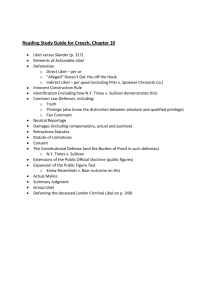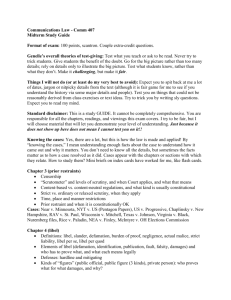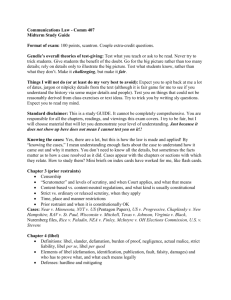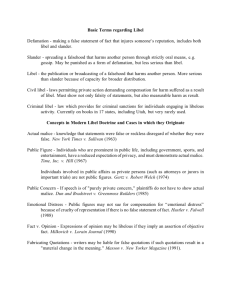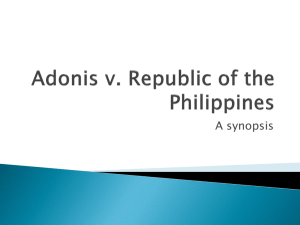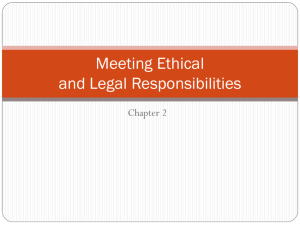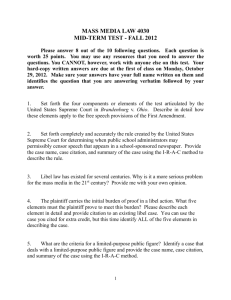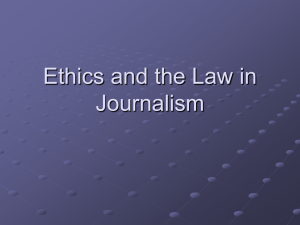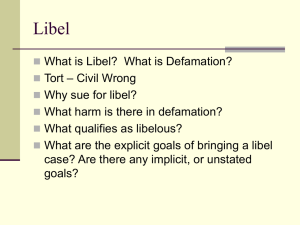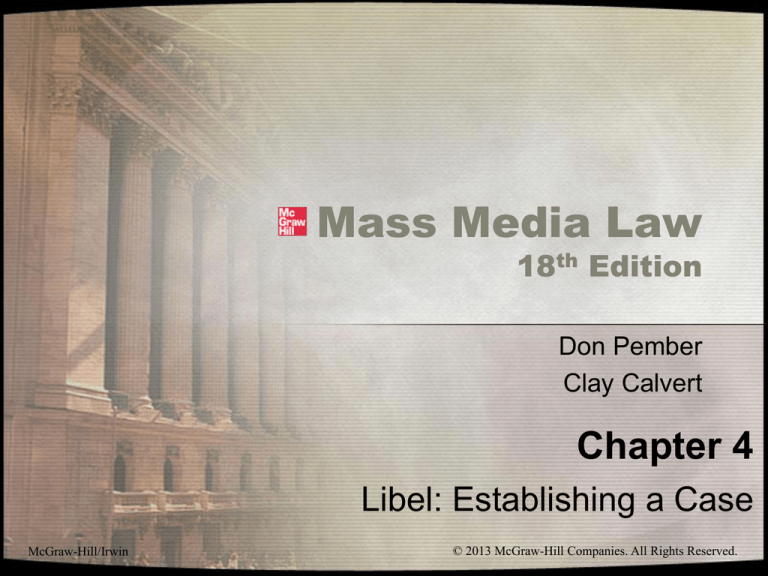
Mass Media Law
18th Edition
Don Pember
Clay Calvert
Chapter 4
Libel: Establishing a Case
McGraw-Hill/Irwin
© 2013 McGraw-Hill Companies. All Rights Reserved.
The Libel Landscape
Defamation (libel)
– The publication or broadcast of any statement that:
• Injures someone’s reputation, or
• Lowers that person’s esteem in the community
4-2
The Libel Landscape
Time and Money
– Expensive and time consuming
– Often brought by plaintiffs who make outrageous
damage claims to win enormous awards
– Complicated and confusing; jurors and even judges
don’t always understand the law
4-3
The Libel Landscape
Time and Money
– Odds are better than 50/50 that press will lose case if
it goes before jury, because:
• Libel law is extremely complex.
• Jurors are more likely to be swayed by tangible
damage to a person’s reputation than abstract First
Amendment principles.
• Many citizens do not hold mass media in high
regard.
4-4
The Libel Landscape
The Lawsuit as a Weapon
– The injured party, or the plaintiff, initiates the lawsuit
to:
• Repair any damage to reputation
• Collect money damages to compensate for harm
to reputation
4-5
Elements of Libel
To win a libel suit, a plaintiff must prove:
– The libel was published
– The words were of and concerning the plaintiff
– The material is defamatory
– The material is false
– The defendant was at fault
4-6
Elements of Libel
Publication
– When one person, in addition to the writer and the
person defamed, sees or hears the material
– Presumed publication – if the material appears in a
mass media outlet, it is automatically presumed by
the courts to be published
4-7
Elements of Libel
Publication
– Republication rule – every republication of a libel is a
new libel
• Attributing a libel to a third party will not shield
people from a lawsuit
• Distributors are exempt from the republication rule
as long as they did not have scienter (guilty
knowledge) of the contents before distribution
4-8
Elements of Libel
Libel on the Internet
– Online service providers (OSPs) are liable for libelous
information if they are the creator or originator of the
material
– OSPs are protected from libel actions if they are
merely transmitting other’s content
4-9
Elements of Libel
Identification
– The defamatory statement is “of or concerning
him/her”
– Can be identified by:
•
•
•
•
Name
Nickname
Photograph
References that would identify only one person
4-10
Elements of Libel
Group Identification
– Statements made about a very large group cannot be
used as the basis for a libel suit by one member of
the group
– If the group is small, individual members of the group
may be able to bring a libel suit for comments made
about the entire group
4-11
Elements of Libel
Defamation
– Libel per se – words that are libelous on their face
– Libel per quod – words that are innocent on their face
and only become defamatory when other facts are
known
4-12
Elements of Libel
Defamation: Considerations
– Juries and judges consider:
•
•
•
•
Words in light of their ordinary meaning
Innuendo as potentially defamatory
Words in context of entire piece
Pure opinion is not defamatory
4-13
Elements of Libel
Defamation: Sources Of Libel Suits
– Libel suits can arise from:
•
•
•
•
Imputations of criminal behavior
Sexual references and implications
Personal habits
Ridicule
4-14
Elements of Libel
Defamation: Business Reputation
– Libel law goes furthest in protecting persons in their
business and occupations
– Single mistake rule – stories that suggest someone
make one mistake in their business dealings may not
be defamatory; stories that suggest a pattern of
incompetence would be defamatory
4-15
Elements of Libel
Defamation: Trade Libel
– Criticism of a product is called “trade libel” but is not
really libel at all, as it focuses on the product itself.
– To prove trade libel, a plaintiff must show:
• Statements about the product are false
• Specific monetary loss because of the false
statements
• False comments were motivated by ill will or actual
malice
4-16
Elements of Libel
Falsity
– Not every plaintiff must meet this requirement.
Private-person plaintiffs only need to prove falsity if
statements are “matters of public concern.” If not of
public concern, defendant must prove it is true.
– If the proven truth leaves a different impression of the
plaintiff in the minds of the jury than the impression
created by the defamatory falsehood
4-17
Elements of Libel
Falsity
– Evidence presented in court must go to the heart of
the libelous comments; the “sting” of the libel must be
false
– Minor errors, unless they are at the heart of the libel,
will not result in a finding of falsity
4-18

